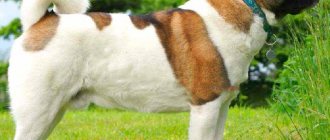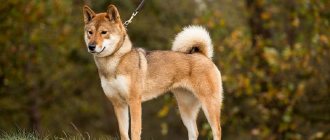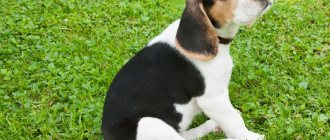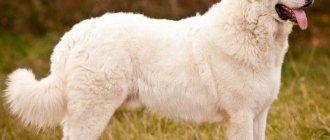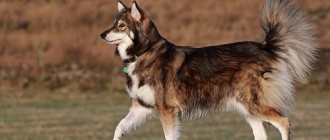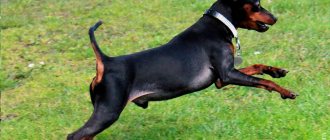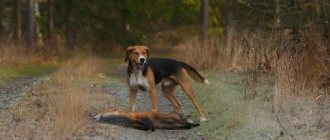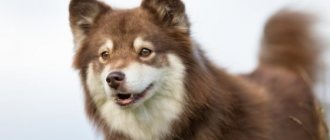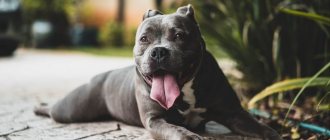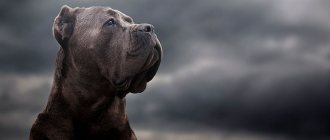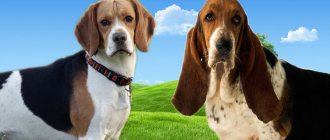Breed characteristics
| Short description | |
| Origin: | Japan |
| Conditions of detention: | Apartment, private house, street |
| Purpose: | Companion, guard, service dog |
| Color: | Pure white, brindle, red-fawn and sesame (red-fawn hair with a black tip). All colors except white have “urajiro” - lightened hair on the sides of the muzzle, on the cheekbones, lower jaw, neck and chest, on the body, tail and on the inside of the paws |
| Wool length: | Long, has guard hair and undercoat |
| Adult dog size: | The height of females is 57-65 cm, males 66-71 cm. Weight of females is 31-44 kg, males 41-51 kg. |
| Average life expectancy: | 13 years |
| Walk: | Every day for two hours, twice |
| Physical activity needs: | Average physical activity needs (active games while walking) |
| Fédération Cynologique Internationale (FIC) classification: | Group 5: Spitz and primitive breeds; Section 5: Asian Spitz and related breeds. |
| Puppy price: | A show-class puppy, from champion parents, with good prospects at exhibitions - from 50-70 thousand rubles. A pet-class puppy (marriage based on breed characteristics) can be bought for 15-20 thousand rubles. A standard puppy without defects and without unique parents is sold for 30-40 thousand rubles. |
Breed Features
Akita Inu is considered a relatively large breed of dog. Representatives of this breed have a strong build and well-developed muscles. At the withers, adult males reach 65-75 mm, the weight of the animal ranges from 35 to 45 kilograms. Females are smaller in size, on average their weight is between 30 and 40 kilograms.
Akita Inu's coat is usually of medium length, however, there are also long-haired individuals. A typical representative of the breed will definitely have a soft and dense undercoat. The average length of the fur is 5 cm, but it is longer on the tail and belly. Akita Inu has three types of color: red, white and striped (tiger). Red and striped dogs have a white color on the muzzle, chest and inner surface of the paws. White Akitu Inus do not have a single spot.
History of the origin of the species
Akita Inu is included in the list of six breeds of the oldest Japanese dogs subject to state protection. Based on data from archaeological excavations and found artifacts, scientists conclude that the Akita Inu has a history of more than three thousand years. In those ancient images, the ancestors of modern Akitas appeared slightly smaller in size and had more pronounced Spitz-like features.
The breed was formed in Akita Prefecture, which is located in the northeast of the island of Honshu. The mountainous region is characterized by very harsh winters, which contributed to the survival of only the strongest, hardiest individuals with water-repellent coats and thick, warm undercoats. Already in the 6th century, clubs were formed in Japan that were engaged in breeding and training Akitas, and from the 15th century, clubs began to keep stud books.
Initially, from the total number of Akitas, hunting dogs – “ Matagi Ken ” – were especially distinguished, then a fighting branch was separated. During World War II, some Japanese Akitas gave birth to German Shepherds, and most were exterminated for material for sewing warm military clothing.
These three branches are still clearly visible throughout the Japanese Akita population . But there are also American Akita Inu, which descended from dogs exported from Japan to America. American Akitas are already following their own path of development; they differ from their ancestors in being larger in size.
In the post-war years, Japanese dog handlers were able to breed from a sharply reduced and changed population of dogs similar to true Akitas - “ Matagi Ken ”, with which in former times hunters even went to hunt bears.
The Japanese are very protective of Akitas; outstanding individuals are even declared “Natural Monuments”. In general, the breed is called the “treasure of Japan.”
The most famous and legendary representative of the breed is Hachiko. The devotion of this dog is glorified by Japanese poets, film directors and musicians. The world learned the heart-wrenching story thanks to the 2009 film “Hachiko” starring Richard Gere. The dog, which in the 1930s waited for nine years for its now deceased owner on the train platform, was already honored with a monument during its lifetime. On the day of Hachiko's death, mourning was declared in the country as a sign of endless respect. Throughout the world, the name Hachiko has become a symbol of love and fidelity.
History of the breed
Akita Inu is a brave and loyal friend from Japan. This is a self-sufficient dog breed with high intelligence. In Japan it is a symbol of devotion, love, family happiness and financial wealth. When training, owners need to show firmness and perseverance.
Akita Inu is an ancient dog breed from Japan. "Akita" is a prefecture in Japan, "inu" means dog. In Japan, these dogs lived at court, and later only noble people could have them. The dog became elite and keeping it turned into a kind of ritual. Each dog had a servant. Collars and leashes were individually made for Akitu Inu, which showed the status of the owner and the rank of the dog. This breed of dog was also used in hunting and dog fighting. In the First World War they took it to the battlefield. After the war, only some dogs remained alive, which became the ancestors. In America, the American Akita was bred from the Japanese Akita.
Currently, this breed of dog is known throughout the world, thanks to the story of “Hachiko”, where a faithful dog waited for its owner. For nine years after the death of the owner, the dog came to the same place to meet the owner from work. A monument was erected to the dog Hachiko.
Today, the Akita Inu is a companion dog. Only a few enthusiasts use dogs for hunting.
Distinctive features
Breed standards:
- The head is positioned in proportion to the body. Wide forehead without wrinkles, with a clearly defined transition from forehead to muzzle. Nose with a large black lobe. It is not desirable, but it is acceptable that white dogs have a lighter and more diffuse color. The muzzle is wide, tapering towards the nose.
- The eyes are small brown, with slightly upturned outer corners, giving the impression of a triangular eye shape. Moderately wide apart. It is believed that the closer to black the shade of the eyes, the better.
- The ears are in the middle, thick, triangular in shape with semicircular tips. Standing, leaning forward. Moderately wide apart.
- bite , powerful lips and close-fitting lips.
- They have a muscular and thick neck without a dewlap, located in proportion to the head.
- The paws are powerful and well developed, thick and round in shape. The movements in the gait are elastic.
- The body is balanced, the physique is strong. The height at the withers relative to the length of the body is 10:11, and the female looks more elongated than the males. Has a straight back, deep chest and a well-shaped belly.
- The coat has guard hairs - hard and straight, as well as a soft, thick undercoat. Guard hairs grow in two layers: the outer one is long, the inner one is shorter. Together with the undercoat, three layers of wool are obtained. The function of the layers is as follows: the undercoat warms the dog, the water-repellent outer hair protects it from getting wet by snow or water. Therefore, Akitas tolerate cold and rain well. The hair on the “pants” and shoulder blades is longer than on other parts of the body. The hair on the tail is the longest.
- They have a thick, high-set tail, curled over the back .
Attitude towards children and pets
They will be tolerant of children and pets if they have lived with them since childhood.
Dogs have a good memory, which is why they can remember the slightest insult from a child . This fact should not be ignored. A hidden grudge can backfire. If you get along with the dog, he will play for hours with the child and is patient. Bitches are more suitable for a family.
Aggressive towards other dogs . Akita Inu always tries to dominate dogs, which causes fights. If you have pets, conflicts may arise.
Photo of an adult dog
How to choose a strong and healthy Akita Inu puppy
The day has come to go to the nursery for a cute puppy. Babies should be kept in a clean enclosure, without a specific unpleasant odor, which is very important. First of all, the breeder will demonstrate the numerous awards that his pets have received. Listen carefully, but don’t be easily fooled by all the big titles and championship accolades. If possible, you need to look at the parents of the future pet. The main 10 signs that will help you choose a healthy Akita Inu puppy:
- shiny and moist nose;
- clean ears, pink;
- lively, clear look;
- clean eyes, without any discharge;
- full number of teeth and correct bite;
- healthy skin, without parasites, sores and acne;
- silky, shiny coat;
- lymph nodes of normal size;
- the tail is without creases or docked;
- no bloating.
A good proof that the animal is healthy is a written document of purchase and sale. If the Akita Inu puppy develops abnormalities over time, according to the contract, the pet can be returned. Having “insurance” with the buyer will reduce the risk that the seller will slip in a problem animal.
Photos of puppies
Features of character and behavior
The Japanese would not be able to appreciate this dog if it did not suit them in character and behavior. Akita, like a real samurai, has a reserved character, behaves with dignity, is reasonable and intelligent. But behind the calm restraint hides kindness, sincere joy and a hot temperament. Akita Inu is a worthy example of canine devotion and fidelity. You need to love a dog and then it will reciprocate.
Advantages
The advantages of the Akita include its devotion, restraint, intelligence, and curiosity. Akita is capable of selflessly standing up for its owner and coming to the aid of its relatives, despite the degree of danger, sometimes risking its life.
Flaws
The breed's minor disadvantages include the dog's rather late maturation, which requires more careful and lengthy training. Teenage curiosity and childish fun can sometimes be excessive. Impatient or rude owners may experience the dog's pride and insubordination, as the dog does not like strong pressure and tends to dominate.
Akita Inu character
Akita Inus have good personalities, making them wonderful family pets. They are known as quiet dogs that only bark when required. Many lovers of this breed say that Akita Inus make them feel relaxed and calm, and therefore help people cope with stress.
Under the mask of calm lies a real fighter who should not be angered. Affectionateness is accompanied by extreme restraint in expressing emotions: having met you from work, the dog will joyfully jump around you... for exactly five minutes, then it will prefer to calmly observe events from the side. Akita Inus love to play, but they end the game as soon as they get bored with it. An Akita will not, like a Labrador or a collie, run around for hours after a ball thrown to it.
In addition to their calm, sociable nature, Akita Inus are known for their cleanliness, with some people comparing them to cats for their lack of odor and clean appearance.
However, since Akita Inu have possessive and hunting instincts, it is advisable to accustom them to communicate with other animals at an early age. Akita Inus that have been raised with other animals, cats or dogs, will continue to get along well with them, but without early socialization they can be aggressive towards other pets, especially dogs of the same sex.
The Akita Inu is an intelligent and calm dog, but at the same time independent and strong-willed, so training such a dog may not be easy. This breed is better suited to people with a certain level of experience with large dogs.
Very loyal, Akita Inus are powerful protectors, which makes them good watchdogs. The Akita Inu can be very stubborn and assertive and if not given enough exercise or bored, can become destructive or difficult to control. Akita Inu needs a fair amount of exercise and long walks. In addition, these dogs cope with transporting or moving various loads: they can easily be harnessed to a small cart or sled.
We advise you to read: Alaskan Malamute Dog Breed
Akita Inu dogs are very patient and loyal, get along well with children and tend to protect them. Akita Inus are excellent in communicating with children, especially if they grew up in the house at the same time as them. As a rule, these dogs equally recognize all members of the owner's family. Incomparable watchmen, they are also considered “talking”: various modulations of the growl create the effect of a kind of “dog” speech. As a rule, Akita Inu has a special growling greeting for each family member.
The Akita's attitude towards strangers is usually neutral. She is not inclined to attack a person, but she will warn her owner about the appearance of a stranger on her territory - often with a roar. In general, the Akita is a calm, balanced dog that loves children if raised with them. But you can’t leave children alone with an Akita, especially if friends come over and start noisy games. The dog may not appreciate the jokes of the little naughty boys and will decide to come to the aid of his owner’s children.
Care and maintenance
- The dog's nails are trimmed regularly (1-2 times a month as needed).
- Cleaning your ears and teeth (at least once a week). The puppy begins to be accustomed to all these procedures from early childhood, otherwise the dog may experience stress and even snap back or not allow him to come near you.
- After walks in the warm season, the dog is always examined for timely detection of ticks and fleas. Spotted ticks are removed with tweezers, carefully twisting them out of the skin. If after discovering a tick, your pet’s condition begins to worsen, call a doctor immediately; the tick may be contagious.
- Fleas are destroyed with special shampoos or drops. You can put a special collar on your dog in advance, soaked in anti-flea and tick medicine.
Nutrition
There is only one requirement for nutrition - it must be sufficient and balanced. The type of food (natural food, dry food) is chosen by the owner, taking into account the opinion of the veterinarian and the condition of the dog.
- Akitas are undemanding when it comes to food, and may prefer rice porridge with vegetables and sea fish to meat, like real Japanese. In addition to cereals, vegetables and boiled seafood, the puppies' diet must include lean meat (veal), eggs, milk and calcined cottage cheese - unless there is an individual intolerance to these products. It is necessary to add vitamins to the feed.
- Adult Akitas are usually switched to ready-made food, dry or wet, since in natural feeding it is difficult to ensure the presence of all the minerals and nutrients necessary for the dog. Ready-made food is desirable premium class, and not cheap, since they contain soy, which Akitas are not genetically accustomed to digest.
- Akita owners often select food based on rice, vegetables and fish, but not based on wheat, corn and meat. You should buy food that is strictly labeled according to the age of the dog, and wet food (canned food) is better digestible.
You should not overfeed your pet, especially if it doesn’t move enough, as Akitas have a tendency to become obese. And remember - no sweets, salty or smoked foods!
Small puppies are fed up to 6 times a day in small portions, gradually transitioning the adult dog to two meals a day.
Health
The health of the Akita Inu is strong, which is due to the very history of the existence and development of the breed in the harsh conditions of the Japanese mountains. You can help your pet stay healthy through close communication with a veterinarian and timely immunization.
Vaccinations
The first vaccinations are given to the puppy in the nursery: at the age of 4 weeks against distemper and enteritis. Then according to the following schedule:
- at 8 weeks – again from plague, enteritis, as well as from hepatitis and leptospirosis;
- at 12 weeks - from rabies.
After vaccinations, quarantine is maintained for 1 month. The dog goes to the new owner with a veterinary passport; all that remains is to continue it in accordance with the vaccination calendar compiled by the veterinarian.
Vaccinations against plague, enteritis and rabies are repeated every year, and if the period between vaccinations has not expired, then quarantine is no longer necessary. Before vaccinations, it is necessary to carry out deworming.
Diseases
There are some diseases inherent to this breed:
- hip dysplasia;
- cataract and glaucoma;
- blood clotting disorder;
- adenoma of the sebaceous glands.
Walk
Ideal conditions are when the dog lives in a large area and is not limited in its walking. But this doesn't happen often. In urban conditions or when movement is restricted (kept in an enclosure), it is necessary to walk the dog 2 times a day for a long time, at least 1.5-2 hours. The dog has a lot of energy, and it needs to be released on a walk. Akita loves not only to run, but also to spend time playing.
Physical exercise while walking should be age appropriate . So, Akitas are very strong, and by the age of one year they can easily pull a sled with a child, but their backbone is not yet fully formed, the muscles have not become stronger - excessive loads cause harm to the young body. It is better to let a teenage dog run, jump, play with a child, toys or other dogs during a walk.
Grooming
- The Akita's very thick coat requires weekly brushing. Usually this is enough. But during the molting period (spring and autumn), the combing procedure should be carried out at least every other day, this is especially true for dogs living in an apartment.
- This breed does not need a haircut. It is recommended to wash with shampoo only 2-3 times a year so that the wool does not lose its water-repellent properties due to frequent washing.
Nutrition
When it comes to nutrition, Akita Inus are not too picky. In the homeland of the breed, the best food for Akitas is rice mixed with shark meat. Accordingly, fish must be present in a dog’s diet. Some experts advise adding seaweed to Akita's food.
We advise you to read: Alabai Dog Breed
Be careful when choosing commercial food for your Akita Inu: most of these foods contain a lot of soy, and Akitas do not digest this product well. An adult dog needs to be fed twice a day.
Mating
Despite the fact that the final maturation of Akitas occurs only at two years, females can be bred from 12-15 months, and males from 10-12 months (depending on the degree of readiness of a particular dog).
- Estrus occurs twice a year, usually lasts about 18-25 days , it is best to mate a bitch on 10-14 days from its onset.
- Before the planned mating, the bitch must be shown to a veterinarian to exclude problematic situations during pregnancy. If at the time of the planned pregnancy the vaccination schedule requires vaccination, then they need to be spaced out in time. One month before pregnancy and during it, vaccinations should not be given.
- Recently, vaccines have been released that are labeled “Safe for Pregnant Dogs,” but this should be discussed with your doctor. You also need to clarify the availability of vaccinations and the health status of the male dog.
- You can only breed bitches that are ready for mating (swollen loop, light discharge, indifference when meeting male dogs). If estrus has begun, and the dog does not show interest in the opposite sex and does not “twist” its tail to the side when stroking the croup, then it is better to postpone the “wedding” until next time.
- The first mating of a pair is successful if one of the dogs has experience of this kind, that is, a young male should be mated for the first time with an experienced female , and it is advisable to pair a young bitch with an experienced male. Two inexperienced dogs during a “wedding” may become confused, experience stress, and this will not end well.
- It is recommended to arrange the mating in the dog's territory, but the bitch must be familiar with the surroundings. That is, before an important meeting, it is advisable to bring the dog into the house and introduce it to the “groom” and his owner. Mating is carried out in two stages, on day 1 - the main mating, on the next day - control mating.
The cost of breeding is usually equal to the cost of one Akita Inu puppy. But this is an optional condition; the owner of the male dog can set his own price or take the best, so-called “maintenance” puppy in the future.
Care
The coat of dogs of this breed does not require special care; it can be brushed four times a month. And only twice a year, when the pet begins to shed, is it brushed more often.
For this procedure, two combs are needed, for the short coat and for the undercoat.
The Akita Inu is bathed twice a year; too frequent washing can damage the hair.
Twice a month, it is necessary to trim the nails and brush the teeth with special pastes.
Walks
Akita Inu is a dog with character, so walks should be long and active. As a rule, the dog itself determines where to go and loves to walk without a leash.
As often as possible, let your pet off the leash and give him the opportunity to run around to his heart's content..
This active dog requires regular exercise, so daily walks should be at least two hours a day.
It’s a good idea to change walking places and toys periodically, thereby maintaining the dog’s interest.
Key points in training
You should start training your dog from a very early age. Having acquired a puppy, you need to not only accustom him to street walks, but also teach him the rules of behavior in the family, show him his place in the “master-dog” hierarchy.
Read about how to properly train a dog in the article: “Training a puppy: effective methods from dog handlers, learning commands at home.”
Genetically, the Akita has decent behavior with people and relatives, but it is necessary to push the puppy to the right actions. Otherwise, the puppy will grow into a self-sufficient dog that wants to dominate the pack family. A special feature of Akitas growing up is their long childhood. Only after 2 years does the Akita become an adult dog, childishness disappears, and behavior and body are finally formed.
Responsible and experienced owners usually raise and train the puppy themselves. But inexperienced dog breeders can contact kennel clubs and enroll in OKD courses, where a professional canine instructor works with dogs in groups or individually. With an experienced eye, he will identify problems in the dog’s behavior and help the owner find ways to eliminate them.
The key to successful training is tact and patience, affection and consistency.
Under no circumstances should physical violence be used against an Akita; training should be based only on encouragement and positive emotions.
How to care?
Despite the dog's plush coat and fairly frequent shedding, caring for an Akita is easier than it seems. In general, the basis of care is paying attention to your pet's coat.
Please note that Akitas do not require haircuts or thinning. Therefore, you will have to stock up on a number of combs, in particular during the shedding period, which happens only 2 times a year, but is incredibly abundant.
Don't forget to pay attention to your dog's nails. If the Akita lives in a private sector, or you simply walk with it often and for a long time, then nails should be cut at least 2 times a month. Also, don’t ignore the fact that your dog needs to have its teeth brushed. To do this, you need to buy a special paste, which also comes in the flavor of meat or other delicacies.
Washing the dog is almost impossible, even in the hottest period. This is justified by the fact that wool can lose its waterproofing properties, which are so necessary for the pet. Therefore, the best option is no more than 2 times a year. At the same time, do not forget to purchase a special shampoo for dogs.
How to choose a puppy
- You should only buy a purebred Akita Inu puppy in clubs after studying the dog’s pedigree, its vaccinations, and the reputation of the kennel. The best puppies are born in a small litter, with good pedigree, and do not have allergies or hereditary diseases.
- A healthy puppy is active, curious, eats well, plays, and has clean eyes and ears. This is enough to choose a puppy for the family. More thorough recommendations on the exterior for choosing a future champion will be given by an experienced dog handler or a breeder of this particular breed.
With timely education and proper care, Akita Inu grow up to be loyal friends to their owners, independent individuals capable of not only pleasing, but also protecting their family. There are no particularly difficult moments in keeping an Akita, you just need to love her and she will respond in kind.
What to feed a puppy
Feeding a small Akita Inu is a challenging task. The breed is very sensitive to mistakes in nutrition, and the puppy’s fragile body must receive everything it needs during a period of intensive growth.
| Age (in months) | Diet |
| Up to 1 |
|
| 1-2 |
|
| 2-3 |
|
| 3-6 |
|
| 6-8 |
|
| From 8 |
|
Akita Inu puppies, even at one month of age, are already quite large - the approximate weight of such a baby is 3-4 kg, so the portion size will be quite large.
- for a one-month-old puppy weighing 3.5 kg you will need about 300 grams of food;
- for a four-month old - about 800 grams per day;
- by 8 months the portion will be about 1 kg per day.
The dog's menu will also change depending on age.
| Age | Menu |
| Up to a month |
|
| 1-2 |
|
| 2-3 |
|
| 3-6 |
|
| 6-8 |
|
Photo: wikimedia.org
